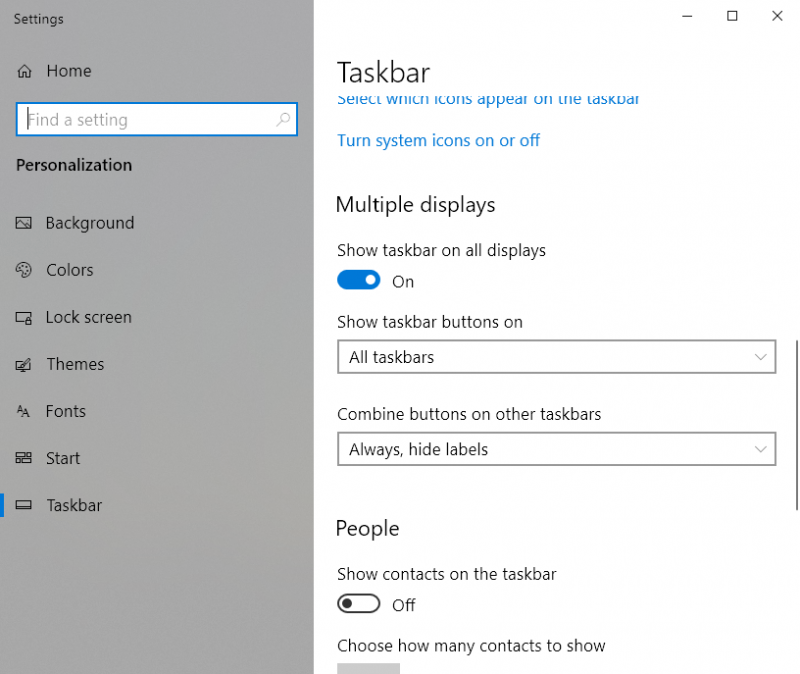

- HOW TO GET A TASKBAR FOR EVERY MONITOR WINDOWS 7
- HOW TO GET A TASKBAR FOR EVERY MONITOR FREE
- HOW TO GET A TASKBAR FOR EVERY MONITOR WINDOWS
What’s on your taskbar? The smart way to configure your taskbar is to populate it with buttons for your most-used applications and documents. (Uncheck this option to return to the standard always-visible taskbar.) Adding Items to the Taskbar

Check the Auto-Hide the Taskbar option, then click OK. When the Taskbar and Start Menu Properties dialog box appears, select the Taskbar tab. To auto hide the taskbar, right-click on any empty area of the taskbar and select Properties from the pop-up menu. (Or, if you’ve moved your taskbar to another side, when you move your cursor to that side of the screen.) In this mode, the taskbar is hidden until you move your cursor to the bottom of the screenwhich then causes the taskbar to slide back up into view.
HOW TO GET A TASKBAR FOR EVERY MONITOR WINDOWS
Windows offers an “auto hide” mode for the taskbar.
HOW TO GET A TASKBAR FOR EVERY MONITOR FREE
Want to free up even more screen real estate? Then hide the taskbar when you’re not using it. This might take a little getting used to, but it’s worth it.

If you position the taskbar at the right side of the screen, the Start menu opens to the left. If you position the taskbar at the left side of the screen, the Start menu opens to the right. That’s all there is to it.īy the way, if you position the taskbar at the top of the screen, the Start menu pulls down instead of popping up. Pull down the Taskbar Location on Screen list and select the desired location: Bottom, Left, Right, or Top, then click OK. Just right-click on any open area of the taskbar and select Properties from the pop-up menu. How do you move the taskbar? It’s really easy. It’s a neat little trick that better fits a widescreen desktop, and one I particularly like. Instead of taking up valuable real estate at the bottom of your screen, you can move the taskbar to the left or right sides, where you probably have more room. This is particular useful when you’re using a widescreen monitorwhich most of us do, these days. In fact, I’d wager that most users don’t know that the taskbar can be moved to any side of the screen. You’re probably used to seeing the taskbar at the bottom of the desktop, because that’s where Windows installs it by default and where the majority of users leave it. Configure it properly, and you may never open the Windows Start menu again! Moving the Taskbar In this regard, the taskbar becomes a one-click area to access both your favorite apps and your open apps.
HOW TO GET A TASKBAR FOR EVERY MONITOR WINDOWS 7
What’s new in Windows 7 is the capability of the taskbar to display buttons not just for open apps and documents, but also for your favorite applicationseven when they’re not running. The Windows 7 taskbar still provides program switching, but it does a whole lot more. Every open application or document had its own button on the taskbar, but if nothing was open, the taskbar was empty. In Windows Vista, Windows XP, and older versions of the operating system, the taskbar existed primarily to help you switch from one open application or document to another. It’s still the taskbar, but it’s not quite the same taskbar you used to use in previous versions of Windows. Well, the taskbar looks a little different in Windows 7, and it has a lot more functionality. You know the Windows taskbar it’s that little strip of real estate at the bottom of the Windows desktop. Turn on Show taskbar on all displays.Microsoft Windows 7 Your Way: Speed Up and Customize Windows Scroll-down a little bit until you find the title Multiple displays. Right-click on your taskbar and select Settings (If you have an older build of Windows 10, it may be called Properties). How do I get the system tray on both monitors Windows 10?

Subsequently, question is, where is the volume icon on the taskbar? To do that, you simply right-click anywhere on the taskbar and choose Properties. From there, you can tweak it to your liking-showing taskbar buttons on all taskbars, or only the monitor where the window is open. Just right-click on the taskbar, head to Properties, and check the "Show Taskbar on All Displays" box. Remember to have your displays in the Extend mode.Ĭorrespondingly, how do I get the system tray on both monitors? Drag your taskbar (the one that contains the system tray) to the screen you want to show the system tray on. Right-click on any taskbar of yours and unlock your taskbar by clicking on lock taskbar in case its checked.


 0 kommentar(er)
0 kommentar(er)
